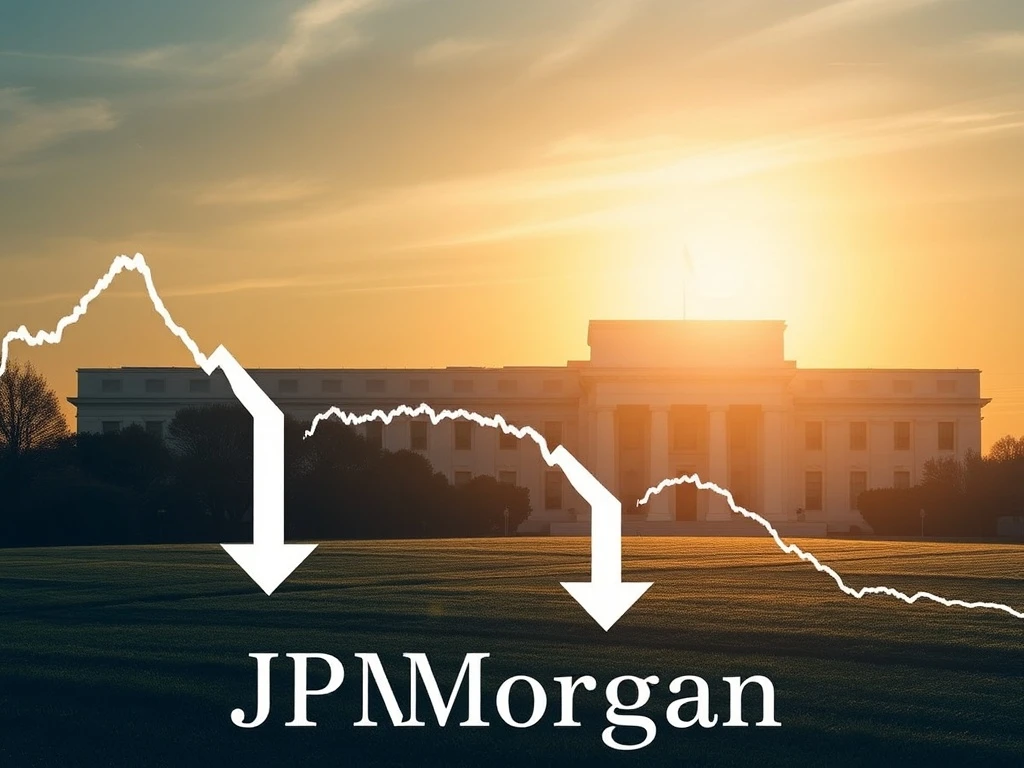Understanding the pulse of the global economy is vital for investors and businesses alike. Financial institutions often provide crucial insights. Therefore, when a major player like JPMorgan revises its economic outlook, the financial world takes notice. Specifically, their updated forecast on **JPMorgan Rate Cuts** by the Federal Reserve carries significant weight. This shift indicates evolving market conditions and potential future economic trajectories. Consequently, businesses and entrepreneurs must pay close attention to these signals. They can inform strategic decisions and investment planning. This article delves into the specifics of JPMorgan’s revised forecast and its potential ramifications.
JPMorgan Rate Cuts: Understanding the Revised Outlook
JPMorgan Chase, a global financial services leader, frequently publishes detailed economic forecasts. These predictions offer valuable perspectives on market trends. Recently, JPMorgan made a notable adjustment to its projections for Federal Reserve interest rate cuts. Initially, their outlook might have been more aggressive. However, new economic data prompted a re-evaluation. This revision reflects a dynamic assessment of inflation trends and labor market strength. Furthermore, it suggests a more cautious approach from the central bank. Understanding these shifts is paramount for market participants. The Federal Reserve’s actions directly influence borrowing costs and investment returns.
Previously, many analysts anticipated several rate cuts in the coming year. JPMorgan’s initial forecast likely mirrored some of these expectations. Nevertheless, persistent inflation and a resilient job market have altered the landscape. For instance, recent Consumer Price Index (CPI) data showed inflation remaining stubbornly high. Similarly, unemployment rates stayed historically low. These factors provide the Federal Reserve with less urgency to cut rates quickly. Consequently, JPMorgan’s economists adjusted their models. They now project fewer or later rate reductions. This new forecast provides a more conservative outlook. It aligns with the Fed’s data-dependent approach.
The Federal Reserve’s Stance on Interest Rates
The Federal Reserve operates with a dual mandate. First, it aims to achieve maximum employment. Second, it strives for price stability, targeting 2% inflation. To fulfill these goals, the Fed uses interest rates as a primary tool. Raising rates curbs inflation by slowing economic activity. Conversely, cutting rates stimulates growth by making borrowing cheaper. Currently, the Fed has maintained a restrictive monetary policy. This stance combats inflation that surged over the past few years. However, high rates also pose risks to economic growth.
Federal Reserve officials closely monitor a range of economic indicators. These include inflation gauges like the Personal Consumption Expenditures (PCE) price index. They also examine employment reports, wage growth, and consumer spending data. Each piece of data informs their policy decisions. Chairman Jerome Powell has consistently emphasized a data-dependent approach. He reiterated the Fed’s commitment to bringing inflation down sustainably. Therefore, any move towards **JPMorgan Rate Cuts** or any rate cuts by the Fed will hinge on these economic readings. The central bank prioritizes long-term economic stability over short-term market fluctuations. This careful approach shapes the future of monetary policy.
Market Implications of Revised JPMorgan Rate Cuts Predictions
Revised forecasts from influential firms like JPMorgan significantly impact financial markets. Investors react to these new projections. For example, fewer anticipated rate cuts can affect equity valuations. Growth stocks, which often benefit from lower borrowing costs, might face headwinds. Conversely, value stocks or sectors less sensitive to interest rates could see relative strength. Furthermore, the bond market experiences direct effects. Bond yields tend to rise when rate cut expectations diminish. This makes existing bonds less attractive. New bonds, however, offer higher returns.
Currency markets also respond to changes in rate expectations. A delay in **JPMorgan Rate Cuts** predictions, or generally fewer rate cuts, could strengthen the U.S. dollar. This occurs because higher interest rates make dollar-denominated assets more appealing. Meanwhile, a stronger dollar can impact multinational corporations. Their overseas earnings may translate into fewer dollars. Commodity prices, too, often react to currency movements and economic outlooks. For instance, a stronger dollar can make dollar-denominated commodities more expensive for international buyers. This might dampen demand. Ultimately, these market shifts require careful analysis from investors. They must adjust their portfolios accordingly.
Broader Economic Outlook and JPMorgan Rate Cuts
The implications of revised rate cut forecasts extend beyond financial markets. They touch the broader economy. Consumer spending, a major driver of economic activity, is directly influenced by interest rates. Higher rates mean higher costs for mortgages, car loans, and credit card debt. This can reduce discretionary spending. Similarly, businesses face increased borrowing costs for expansion or investment. Consequently, this might slow down job creation and capital expenditure. The housing market is particularly sensitive to interest rates. Mortgage rates directly affect affordability and demand. Therefore, fewer rate cuts could prolong challenges for homebuyers.
Conversely, a resilient economy might not need aggressive rate cuts. If inflation moderates naturally while employment remains strong, the Fed has more flexibility. This scenario allows for a ‘soft landing,’ avoiding a recession. JPMorgan’s revised forecast, in essence, reflects this possibility. They might be signaling a more robust economic backdrop than previously thought. This could mean sustained economic growth, albeit with higher borrowing costs. Businesses, therefore, need to assess their financing strategies. They must also evaluate consumer demand in this evolving environment. The balance between inflation control and economic growth remains delicate. This balance guides future policy decisions.
Expert Perspectives on JPMorgan Rate Cuts Forecasts
Financial analysts and economists widely discuss JPMorgan’s revised outlook. Their perspectives often vary. Some experts agree with the more cautious stance. They point to the latest inflation data and strong jobs reports as justification. These economists believe the Fed has ample reason to delay rate cuts. They emphasize the risk of cutting too soon. Such a move could reignite inflationary pressures. This would necessitate further rate hikes later. Other analysts, however, maintain a different view. They argue that the economy shows signs of slowing. They highlight factors like cooling consumer spending in certain sectors. Therefore, they advocate for earlier rate cuts to prevent a deeper downturn.
Furthermore, some experts consider the global economic context. International developments can influence the Federal Reserve’s decisions. Geopolitical events or economic slowdowns abroad might prompt a more accommodative stance. Conversely, robust global growth could reduce the need for domestic stimulus. Ultimately, the consensus around **JPMorgan Rate Cuts** is not uniform. Market participants must consider various viewpoints. They should also conduct their own due diligence. Understanding the rationale behind different forecasts is crucial. It helps in forming a comprehensive investment strategy. This ongoing debate highlights the complexity of economic forecasting. It also underscores the importance of data interpretation.
Navigating Future Federal Reserve Decisions
The Federal Reserve’s upcoming meetings will be closely watched. Each meeting provides an opportunity for policy adjustments. Investors and businesses should monitor the statements from the Federal Open Market Committee (FOMC). These statements often provide forward guidance. They signal the Fed’s likely path for interest rates. Furthermore, speeches by Fed officials offer additional insights. These public remarks can clarify the central bank’s thinking. They often elaborate on the economic conditions influencing policy.
Key economic data releases will also heavily influence future decisions. These include monthly inflation reports, employment figures, and GDP growth numbers. A significant shift in any of these indicators could prompt a change in the Fed’s strategy. For instance, a sudden spike in unemployment might accelerate rate cut discussions. Conversely, a resurgence of inflation could delay them further. Businesses should therefore remain agile. They must adapt their financial planning to these potential shifts. The trajectory of **JPMorgan Rate Cuts** and actual Fed actions will depend on these evolving economic realities. Staying informed is essential for navigating this dynamic landscape.
Conclusion: The Evolving Landscape of JPMorgan Rate Cuts and Beyond
JPMorgan’s revised forecast for Federal Reserve interest rate cuts represents a significant development. It reflects a more nuanced understanding of the current economic environment. Persistent inflation and a resilient labor market are key drivers behind this adjustment. Consequently, the expectation of fewer or later rate reductions has implications across financial markets. From equities to bonds and currencies, investors are recalibrating their strategies. The broader economy also feels the ripple effects. Consumers and businesses face continued higher borrowing costs. However, this scenario also suggests a potentially more robust economic outlook. It indicates a ‘soft landing’ might be achievable.
Ultimately, the Federal Reserve remains data-dependent. Its decisions will continue to hinge on incoming economic reports. While **JPMorgan Rate Cuts** forecasts provide valuable guidance, they are just one piece of the puzzle. Market participants must stay vigilant. They need to monitor economic indicators and central bank communications closely. Adapting to this evolving landscape is crucial. It ensures informed decision-making in an increasingly complex global economy. The journey towards sustainable price stability continues, guided by careful policy adjustments.
Frequently Asked Questions (FAQs)
Q1: What is the significance of JPMorgan’s revised forecast on Federal Reserve rate cuts?
JPMorgan’s revised forecast is significant because JPMorgan is a leading financial institution whose projections influence market sentiment and investment strategies. Their adjustment indicates a shift in expectations regarding the Federal Reserve’s monetary policy, often reflecting new economic data and a more cautious outlook on rate reductions.
Q2: Why did JPMorgan revise its forecast for JPMorgan Rate Cuts?
JPMorgan revised its forecast primarily due to persistent inflation and a resilient labor market. Recent economic data, such as higher-than-expected Consumer Price Index (CPI) readings and consistently low unemployment rates, suggests less urgency for the Federal Reserve to implement aggressive rate cuts in the near term.
Q3: How do fewer anticipated rate cuts impact financial markets?
Fewer anticipated rate cuts can impact financial markets in several ways. It may lead to higher bond yields, potentially strengthening the U.S. dollar, and could create headwinds for growth stocks while possibly benefiting value stocks. Overall, it influences investment decisions across various asset classes.
Q4: What economic indicators does the Federal Reserve monitor when deciding on interest rates?
The Federal Reserve monitors a wide range of economic indicators. Key ones include inflation gauges like the Personal Consumption Expenditures (PCE) price index, employment reports (such as non-farm payrolls and unemployment rates), wage growth, and consumer spending data. These indicators help the Fed assess the economy’s health and guide its policy decisions.
Q5: What does ‘data-dependent’ mean in the context of the Federal Reserve’s policy?
‘Data-dependent’ means the Federal Reserve bases its monetary policy decisions primarily on the latest incoming economic data. Instead of adhering to a fixed schedule, the Fed adjusts its approach to interest rates and other policies in response to real-time information about inflation, employment, and overall economic activity.
Q6: How can businesses and individuals prepare for potential changes in interest rates?
Businesses and individuals can prepare by reviewing their debt obligations and financing strategies. Businesses might explore fixed-rate loans or adjust investment plans. Individuals could consider refinancing mortgages, managing credit card debt, and reviewing savings strategies. Staying informed about economic forecasts and Fed communications is also crucial for proactive planning.
























